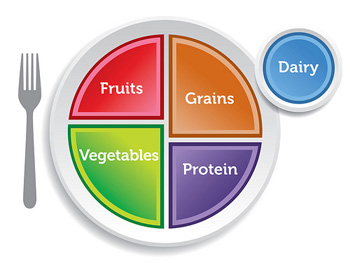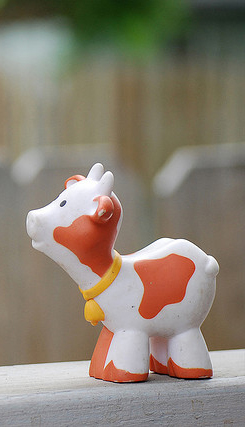 As I admitted before, I made a big change at the beginning of this year and became a ‘flexitarian‘. Why? Well, I was having a dinner with colleagues where nearly no one but myself was eating meat. When I asked what was going on, I got an overwhelming response about how much better it was for the world to cut back on your meat intake.
As I admitted before, I made a big change at the beginning of this year and became a ‘flexitarian‘. Why? Well, I was having a dinner with colleagues where nearly no one but myself was eating meat. When I asked what was going on, I got an overwhelming response about how much better it was for the world to cut back on your meat intake.
Laugh if you want, but I have an ever increasing environmentalist side. So after going home and doing a little research, I was sold. I set out to eat no more than 1/3 of my meals with meat every week, and with half of those as fish. It turns out cutting down was easier than I thought, and nowadays only about 1/5 of my meals are meat-based and I’m actually able to afford organic/free-range/sustainable/etc fairly often when they are.
I will not preach about what or how or why anyone should eat the way I do now. I don’t even know that you should- and after all, I do still love steak and bacon and a whole lot of other meats. But if you’re interested in learning more about cutting back, I recommend checking out the film Food Inc. There are some other books and films out there on the topic, of course, but that’s a good starting point.
Life on the Green SideAs for how it’s affected my life – to be honest, it was so much easier than I ever expected. Of course, it helps that I indulge when its more convenient, but otherwise swapping in alternative proteins and trying out new recipes has been a cinch. I feel noticeably healthier and my vegetable intake has at least doubled (so has my cheese intake, but that’s just ’cause I thought it was a good excuse). My grocery spend is incredibly low and oh yeah, I’m probably in the best shape I’ve been in since I was a teenager.
It did not start off easy for me, though. It seems like the vast majority of people feel instantly better the moment they turn veg, but when I started, my stomach was constantly unsettled and I suffered some sort of psychological meat withdrawals. I found myself literally dreaming about ham (bizarre considering I don’t even like ham to begin with) and practically drooling over cold cuts at lunch. I nearly didn’t make it, but eventually your body adjusts and those feelings do pass. Now, like most vegetarians/flexitarians, I actually end up feeling a bit sluggish and ‘heavy’ when I’ve had too much meat within a short period of time.
A Bit About ProteinShould you dare to try this path as well, you’re biggest worry is probably about your protein intake. I knew that I could not survive this new diet if I didn’t ensure that I had protein with every meal, so I did some research and discovered two very important things:
- We consume way more protein than we really need
- There are nearly as many vegetable proteins / protein substitutes as there are meat types
Go figure.
So, the lowdown on protein is this: you only need about 45 – 70 grams of protein each day depending on gender, age and level of exercise. Or, another way to look at it is proteins should make up between 15 – 30% of your daily calories, which is handy to keep in mind when you’re dividing up your plate. Also, you can get proteins from a variety of sources – not just meat, nuts and soy, but milk, cheese, whole wheat and many vegetables as well. Which are the best sources is a bit of debate, but keeping your meals varied and balanced is always a good way to go and packs more proteins than you think. For a fairly comprehensive look at proteins, check out this article by the US CDC: Protein and this blog that lists out protein-rich foods and serving-sizes: The No-meat Athlete.
In the meantime, here are the proteins that are now driving my meals:
BeansIn addition to being an excellent source of protein, beans are also high in fiber, complex carbs, folate and iron. If you’re not a bean fan, I suggest black beans and red kidney beans as a good place to start. Use them everywhere: salads, soups, wraps, pasta, stews, rice dishes, etc. Beans vary in protein count depending on the type, but they’re generally 7-10g per 1/2 cup cooked.
Daily protein serving: ~1 cup/meal
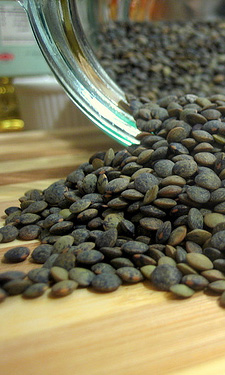 Lentils
Lentils
Lentils are good for fiber, folate, Vitamin B and minerals. They are also sometimes linked to migraines, so keep an eye out for that. Lentils are very interesting and versatile to cook with. Most commonly they’re mixed in with rice or cooked down into soups and curries. Cooked lentils can also be sneaked into countless other places: salads, pasta sauces, casseroles, etc. My personal favorite discovery, though, is that when spiced properly and cooked with a bit less water, they make a very compelling replacement for ground beef. Lentils also have about 7-10g per 1/2 cup cooked, but can be more difficult to eat in such high quantity.
Daily protein serving: ~1 cup/meal
Chickpeas & HummusChickpeas are so popular these days, they’re probably the easiest vegetarian protein to adopt. In addition to protein, chickpeas are high in zinc and folate. The peas themselves can be easily cooked and mixed into a variety of dishes and salads. Grinding them into hummus lets you make a protein spread, salad dressing or dip. Though deep-fried, falafel (ground-up chickpea ‘patties’) is a useful way to use chickpeas in place of whole chunks of meat in things like sandwiches and wraps. Chickpeas have about 6g protein per 1/2 cup and depending on the ingredient mix for the hummus, it’s about the same.
Daily protein serving: ~1.5 cups/meal
TofuTofu gets a bad wrap. Westerners just don’t seem to get it right, and I firmly believe that half of that is trying to make it into something it’s not, i.e. tofurkey. Fried, firm tofu is truly excellent and packs about 10g of protein per 1/2 cup. Stir-fries are the most common use for tofu, but don’t be afraid to stick it in soups, curries, casseroles and just generally treat it like meat.
Daily protein serving: ~3/4 cup/meal
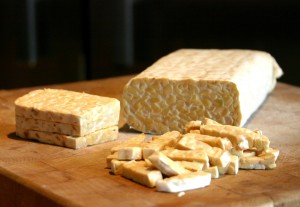 Tempeh
Tempeh
Tempeh is very similar to tofu, but is made more of ‘whole beans’ and has a much firmer, chewier texture. This is my single favorite vegetarian protein, but it is incredibly hard to find in the grocery store. Seek it out and then use as you would fajita meat or meat patties. Just 1/2 cup of tempeh has 15g of protein.
Daily protein serving: 1/2 cup/meal
SoyThe father of both tofu and tempeh, soy is probably the staple vegetarian protein. I keep a bag of frozen, shelled soy beans on hand at all times. Then I pop them in salads, pastas and stir-fries or even just eat a small bowl on the side with some salt/seasonings. You should also keep soy milk on hand and use it in place of milks and creams when you’re looking for some extra protein. 1/2 cup of soy beans has 15g of protein and a cup of soy milk has about 8.
Daily protein serving: 1/2 cup/meal
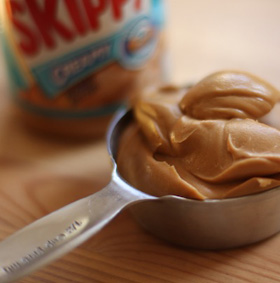 Nuts & Seeds
Nuts & Seeds
And of course, good old nuts, seeds and nut butters are a classic non-meat source of protein. All types vary, but in general, 1/2 cup of nuts or seeds has between 10 – 16 grams of protein and the nut butter form has twice that. I think you know how to put them to use.
Daily protein serving: 1/2 cup raw/meal or 1/4 cup butter/meal
EggsEggs would seem like a given, but I constantly forget about them. Make quiches, add a boiled egg to your salad or sandwich, crack an egg into your pasta sauce or stir-fry … just remember to utilize them. 1 medium/large egg has about 6g of protein.
Daily protein serving: 2 eggs/meal
QuinoaFinally, quinoa is a kind of ‘superfood’ du jour and one of its magic powers is containing about 8g of protein per cooked cup. That’s the least of everything I’ve listed, but when you consider that quinoa is a unique kind of seed that’s used as a grain, it becomes very easy to gobble up quinoa by the bowlful. In general, use quinoa as you would rice or couscous.
Daily protein serving: 2 cups/meal
I’m sure I’ve missed something, but this list makes up my current staples. As a final note, I’ll leave you with a few surprise protein counts that you should always keep in mind:
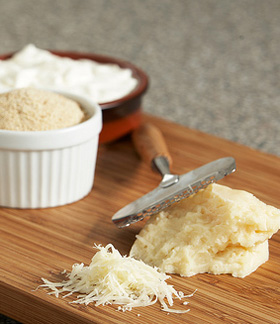 1 cup milk = 8g protein
1 cup milk = 8g protein- 1/2 cup cottage cheese = 14g protein
- 1/2 cup feta cheese = 21g protein
- 1oz soft cheese (Mozzarella, Brie) = 6g protein
- 1oz med cheese (cheddar, swiss) = 7g protein
- 1oz hard cheese (parmesan) = 10g protein
- 1 cup coked split peas = 16g protein
- 1 cup brussels sprouts = 4g protein
- 1 cup raw broccoli = 4g protein
- 1 cup boiled spinach = 5g protein
- 1 cup dry oats = 11g protein
- 1 cup whole wheat pasta = 7g protein
- 1 cup cooked brown rice = 5g protein

